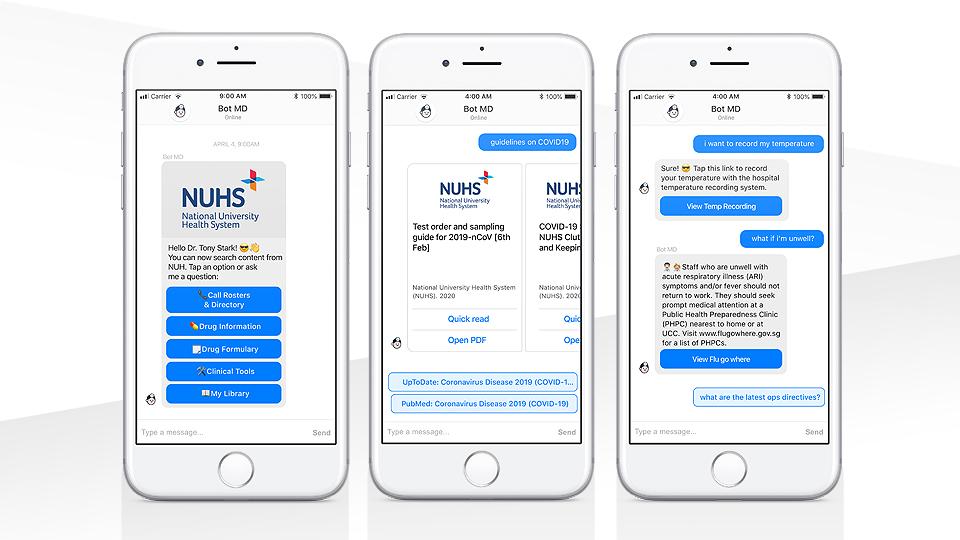
The National University Health System (NUHS) and Bot MD have partnered to launch the NUHS-Bot MD A.I. clinical assistant app for frontline medical staff to gain quick access to hospital-specific information including COVID-19 guidelines and operational directives.
The NUHS-Bot MD A.I. assistant is a chatbot that immediately answers questions from hospital staff about protocols, COVID-19 directives, drug dosage information, drug formulary and on-call rosters.
It also allows hospital staff to record their temperatures by integrating the daily temperature reporting form within the Bot interface.
The NUHS-Bot MD A.I. assistant is accessible on any smartphone device and acts as a 24/7 virtual assistant that can help healthcare professionals.
Being able to access this information and having it on hand means that healthcare professionals don’t need to go through multiple sources such as searching through the intranet, calling the pharmacy for drug enquiries, or searching through webpages to find out who is on call. They just need to key in their queries, and they can receive answers instantly wherever they are.
The smartphone app allows hospitals to build custom clinical tools based on their own guidelines and protocols.
One such example is a chemotherapy cost calculator that instantly calculates treatment costs based on the dosing regimens and drug prices at the National University Cancer Institute Singapore.
This serves as a useful financial counselling aid for their clinicians and frontline medical social workers to help cancer patients determine appropriate treatment options.
Pilot helps develop Chatbot according to user’s needs
The NUHS-Bot MD A.I. clinical assistant was developed in six months and piloted in December 2019.
The pilot allowed the development team to receive feedback on the usability of the interface, user patterns, the type of information users seek most, to give feedback on questions that the chatbot could not answer, which they then trained it to do.
That process continues today, said Dr Ngiam, NUHS Group Chief Technology Officer “We are finding out the kind of content and features users want on the chatbot and making sure they are kept updated.”
“Understanding and seeking out user needs is a vital process,” citing the pilot phase as one of the key steps in the project.
Over 500 doctors, nurses, pharmacists and medical social workers from NUHS are now using the chatbot under the first phase of its rollout. There are plans to expand access to over 3,000 more healthcare professionals across the NUHS cluster by the end of 2020, including to Ng Teng Fong General Hospital, Alexandra Hospital, and the National University Polyclinics.
The NUHS-Bot MD A.I. clinical assistant app is just one of the many initiatives by NUHS to incorporate artificial intelligence in healthcare.
How Chatbot can provide assistance fighting COVID-19
The chatbot can make a real difference in the current battle against the COVID-19 pandemic.
“Healthcare has become more complex and clinicians need timely information that is easily accessible. Using a familiar messaging format, the NUHS-Bot MD A.I. assistant aims to put the power of information instantly at the fingertips of each and every clinical professional,” said Dr Ngiam.
NUHS has been able to use it to put out the latest COVID-19 directives, protocols and contact numbers quickly for its frontline workers under pressure, who can also use the chatbot to record their daily temperature readings.
“Bot MD’s mission is to empower doctors and nurses around the world. Given the current COVID-19 crisis, we are especially honoured to have the opportunity to help NUHS frontline medical staff get instant access to the clinical information they need, so they can focus on helping the patients they care for,” said Ms. Dorothea Koh, CEO & Co-Founder of Bot MD.
Its use in providing COVID-19-related information to healthcare professionals is an example of how the chatbot can be adapted, and constantly updated, to meet evolving needs.
















